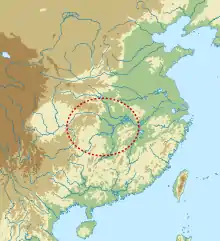Qujialing culture
The Qujialing culture (3400–2600 BC) was a Neolithic civilisation centered primarily on the middle Yangtze River region in Hubei and Hunan, China. The culture succeeded the Daxi culture and reached southern Shaanxi, northern Jiangxi and southwest Henan. Artefact types unique to the culture include ceramic balls and painted spindle whorls; the latter were inherited by the succeeding Shijiahe culture.
 | |||||||
| Geographical range | middle Yangtze | ||||||
|---|---|---|---|---|---|---|---|
| Period | Neolithic | ||||||
| Dates | c. 3400 – c. 2600 BC | ||||||
| Preceded by | Daxi culture | ||||||
| Followed by | Shijiahe culture | ||||||
| Chinese name | |||||||
| Chinese | 屈家嶺文化 | ||||||
| |||||||

The type site at Qujialing was discovered in Jingshan County, Hubei, China. The site was excavated from 1955 to 1957. The remains of chickens, dogs, pigs and sheep were discovered at the site. The remains of fish were discovered in ten storage pits. Egg shell pottery and tripods were also discovered at the site. City walls, man-made water systems, large courtyard buildings, and residential sites were found on the site.[1]
Many of the artefacts from the culture are located in the Hubei Provincial Museum.
See also
References
- "Large Cemetery of Qujialing Culture Discovered at Chenghe Site, Hubei Province". kaogu.cssn.cn. Chinese Academy of Social Sciences. Retrieved 22 April 2019.
- Allan, Sarah (ed), The Formation of Chinese Civilization: An Archaeological Perspective, ISBN 0-300-09382-9